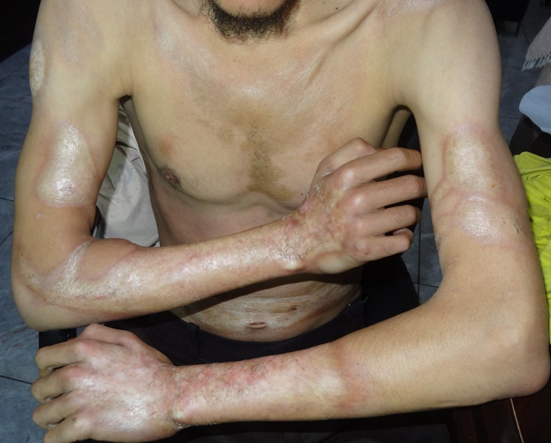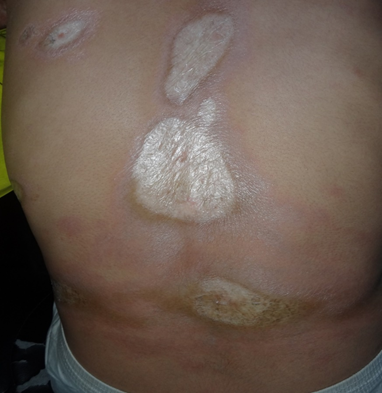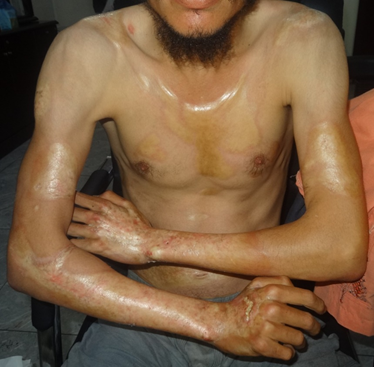Journal of
eISSN: 2574-9943


Case Report Volume 7 Issue 4
1Dermatology Department, Faculty of Medicine and Health Sciences, Sana’a University, Sana’a,Yemen
2Department of Conservative Dentistry, Faculty of Dentistry, Sana’a University, Sana’a,Yemen
Correspondence: Mohammad Ali Alshami, MD, Dermatology Department, Faculty of Medicine and Health Sciences, Sana’a University, Sana’a,Yemen, Tel 00967733760082
Received: October 12, 2023 | Published: October 27, 2023
Citation: Mohammad Ali A, Ahlam Mohamed A, Hadeel Mohammad A. Disabling pansclerotic morphea in an adult Yemeni patient: a case report. J Dermat Cosmetol. 2023;7(4):125-127. DOI: 10.15406/jdc.2023.07.00248
Pansclerotic morphea is a highly rare, treatment-resistant, and debilitating variant of localized morphea that affects the entire thickness of the skin and sometimes involves muscles and bone. It manifests as expanding sclerotic plaques that eventually coalesce over the whole trunk or circumferentially extend into the extremities. It is also associated with an increased risk of cutaneous squamous cell carcinoma. Herein, we present the first case of a 30-year-old male patient with typical features of pansclerotic morphea in Yemen. Our patient’s case is unique because it presents a new sign not reported before, namely the boxer-jump sign, besides other previously reported typical signs.
Keywords: pansclerotic morphea, plaques, localized scleroderma, tip-toe gait, top tank sign, boxer-jump sign
Disabling pansclerotic morphea (DPM) is a rare, severe, and mutilating form of morphea involving the dermis, and contrary to typical morphea, it also affects the subcutaneous tissue, muscle, and bone.1 This condition is primarily observed in children younger than 14 years, starting with arthralgia and stiffness.2 Here, we report a case of adult-onset DPM sparing the face, neck, fingers, and toes.
A 30-year-old man presented with a 13-year history of slowly but steady progressive ‘‘tightening’’ of the skin of the trunk and extremities, starting on the left leg and extending proximally and to the trunk and right limb, progressive skin sclerosis, with contractures of the wrist, knee, and ankle joints, and multiple cutaneous ulcers on both lower limbs. Within a few years of onset, painful contracture deformities of the wrist (claw-hand), knee, and ankle joints develop, impairing the patient’s normal daily activities. The face, neck, fingers, and toes were spared. It started as a linear red macule on the left leg and progressed to the right leg, arms, and trunk, developing intermittent treatment-resistant ulcers. On physical examination, both limbs were circumferentially encased in hard yellow-white skin sleeves, with an extension contracture deformity of the wrist and flexion deformities of the knee and ankle joints, forcing the patient to adopt a tip-toe gait (Figure 1A). Multiple porcelain-white plaques, devoid of hair, sweat, and sebaceous glands, were observed over the trunk, with a belt-like plaque on the waist, giving a picture of the top tank sign (involvement of the central chest, sparing the nipples and lateral chest) (Figure1B–D). An ulcer measuring approximately 3×4 cm covered with a hemorrhagic crust was observed on the dorsolateral aspect of the left foot (Figure 1E). A right arm skin punch biopsy revealed pansclerosis invading the papillary dermis and panniculus into the fascia, confirming the diagnosis. Initially, we considered a differential diagnosis of lichen sclerosus et atrophicus because of the porcelain-white atrophic plaques. However, DPM was later considered a more accurate diagnosis because of the circumferential involvement of the extremities, the rapid progression of the disease, the joint contractures, and the chronic ulcers.

Figure 1A Tiptoe-gait due to sclerosis of the dorsal aspects of feet, flexion contracture of the knee joints, and extension contracture of the wrist joints. Box-jump position. Note the lack of involvement of the toes, and fingers. Note the dorsal flexion of the foot and the dorsiflexion of the ankle, giving the foot a rocker-bottom appearance.

Figure 1B Top-tank sign, involvement of central chest, and sparing of nipples, and lateral chest. The face and fingers are also spared. Flexion contracture of the elbow joints and extension contracture of the wrist joints. Note the complete loss of skin appendages, compared to normal skin.

Figure 1C Multiple different-sized, porcelain-white sclerotic plaques over the back, surrounded by erythematous and yellow-orange zone.

Figure 1D Patient 22 months after treatment showing improvement in all features of disabling pansclerotic morphea.
The patient was administered oral methotrexate (25 mg/week), topical clobetasol ointment, topical mupirocin ointment, and oral azithromycin, as needed. There was rapid relief of pain, an increase in the range of limb movements, softening of sclerotic plaques, and healing of the ulcers (Figure 1E). He is being followed up for relapse, adverse drug side effects, and squamous cell carcinoma. At his latest follow-up visit, 22 months after the first presentation, no ulcers, no evidence for SCC, and no further disease progression were observed.
Disabling pansclerotic morphea (DPM) is an extremely rare subtype characterized by generalized full-thickness skin involvement, resulting in severe joint deformities and later immobility.3 While morphea can spontaneously remit, DPM exhibits extremely aggressive progression.4 Standard treatments are available; however, many cases are drug-resistant and may even be lethal. New drugs are continuously being developed, but these remain too expensive for our country.5 Moreover, infections are the most common adverse events, and other possible side effects include cytopenia (in particular neutropenia), transaminitis, and hypercholesterolemia. Less than 80 cases have been reported in many countries except Yemen.
The present case is the first in Yemen to demonstrate typical signs of DPM, such as the tank-top-sign and tiptoe-gait-sign, in addition to a new sign, the boxer-jump-sign, which has not been reported before6 (Figure 1A). We treated the patient with oral prednisolone combined with oral methotrexate and topical potent steroids, with a good response, evident in the healing of multiple ulcers, softening of the plaques, cessation of inflammation, and increase in joint mobility; however, despite their low price, the patient was sometimes not able to buy the medication. He is currently being followed up for ulcer-related squamous cell carcinoma.7,8
Our case demonstrates typical signs of DPM in a male Yemeni patient and presents a new sign, the boxer-jump sign, which has not been reported before. We believe that our findings will increase the knowledge and awareness of this disease among dermatologists and enable early diagnosis and treatment of DPM, thus decreasing its morbidity and mortality.
None.
Authors declare there is no conflict of interest.

©2023 Mohammad, et al. This is an open access article distributed under the terms of the, which permits unrestricted use, distribution, and build upon your work non-commercially.